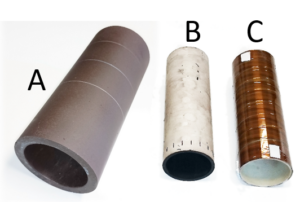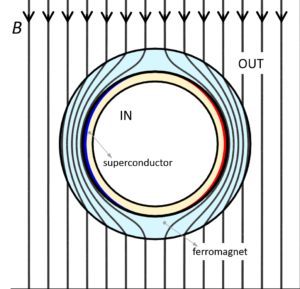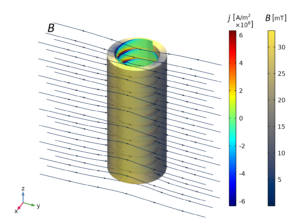Magnetic properties of superconducting and (ferro)magnetic materials are complementary. The superconducting material after the transition into the superconducting state (under the critical temperature) expels magnetic field from its interior, the ferromagnetic material, on the contrary, concentrates the magnetic field inside its volume. It turns out that combination of superconducting and ferromagnetic layers of suitable geometrical and material parameters can exhibit a unique property of magnetic cloaking. In this situation, inside the volume enclosed by such combined layers the magnetic field is zero, while outside of this volume, at the outer side of the layers, the magnetic field is not affected. This is the basic principle of the cloak of magnetic invisibility – the subject of intensive experimental research as well as theoretical and computational analysis in the Department of Superconductors.

Fig. 1
Fig. 1: Experimental model of magnetic invisibility cloak. Ferromagnetic layer in the shape of hollow cylinder (A) and two types of superconducting layer – hollow cylinder from a bulk superconductor (B) and a fiberglass tube with spirally wound thin superconducting tape (C). The magnetic invisibility cloak is formed by inserting the superconducting part B or C inside the ferromagnetic hollow cylinder A.

Fig. 2
Fig. 2: Distribution of magnetic field B (flux lines) inside and outside of the magnetic invisibility cloak, in the plane perpendicular to the axis of the cloak from Fig. 1, in the region around half of its length. Homogeneous external magnetic field is concentrated in the ferromagnetic layer and is expelled from the superconducting layer of the cloak. In total, the magnetic field inside the cloak (IN) is zero and outside of the cloak (OUT) the homogeneous field distribution is not affected in any way.

Fig. 3
Fig. 3: 3D distribution of magnetic field B and induced current density j, calculated using numerical methods for the case of the magnetic invisibility cloak with the superconducting layer formed by spirally wound superconducting tape.
Selected publications:
Nagasaki, Y., Solovyov, M., and Gömöry, F.: Experimental and numerical investigation of shielding performance of superconducting magnetic shields using coated conductor tapes, IEEE Trans. Applied Supercond. 28 (2018) 6601905.
Soloviov, M., Šouc, J., Gömöry, F., Rikel, M., Mikulášová, E., Ušáková, M., and Ušák, E. : Bulk and CC-tape based superconducting shields for magnetic cloaks, IEEE Trans. Applied Supercond. 27 (2017) 8800204.
Soloviov, M., Šouc, J., Kováč, J., Gömöry, F., Mikulášová, E., Ušáková, M., and Ušák, E.: Design of magnetic cloak for experiments in AC regime, (Invited paper), IEEE Trans. Applied Supercond. 26 (2016) 0500206.
Šouc, J., Soloviov, M., and Gömöry, F.: Hiding objects in AC magnetic fields of power grid frequency by two-shell ferromagnetic/superconducting cloak, Applied Phys. Lett. 109 (2016) 033507.
Soloviov, M., Šouc, J., and Gömöry, F.: Magnetic cloak for low frequency AC magnetic field (Invited Paper), IEEE Trans. Applied Supercond. 25 (2015) 8800705.
Gömöry, F., Soloviov, M., and Šouc, J.: Magnetization loop modelling for superconducting/ferromagnetic tube of an ac magnetic cloak, Supercond. Sci Technol. 28 (2015) 044001.
Gömöry, F., Soloviov, M., Šouc, J., Vojenčiak, M., and Švec, P.: Dissipation in superconductor/ferromagnet multilayers for AC magnetic cloating, J. Supercond. Novel Magn. 28 (2015) 725-729.
Šouc, J., Soloviov, M., Gömöry, F., Camps, J., Navau, C., and Sanchez, A.: A quasistatic magnetic cloak, New J. Phys. 15 (2013) 053019.
Gömöry, F., Soloviov, M., Šouc, J., Navau, C., Camps, J., and Sanchez, A.: Experimental realization of a magnetic cloak, Science 335 (2012) 1466-1468.
 Contact
Contact Intranet
Intranet SK
SK

